MACH Architecture is designed to help launch products quickly, support customizable and changeable components, and long-term scalability. MACH Architecture can be applied to many products but is particularly popular with digital commerce and digital transformation.
Organizations today face uncertainty and changing demands with the knowledge that technology, in particular, needs to change regularly. Organizations need internal infrastructure and optimized applications to deliver the most significant value. Further, organizations must ensure that their internal and external products can shift quickly to changes in customer demands, new technologies, and evolving business conditions.
The concept of “composable technology” is the idea that organizations can explore and adopt innovative technology to shift and adapt more quickly. According to one Gartner report, 60% of organizations seek composability in their software investments. One of the ways that organizations are ensuring they have a composable environment is with MACH architecture – architecture that is designed to be modular (microservices), connected via API (API-led), scalable (cloud-based), and de-coupled (headless). This guide will walk through all the concepts of MACH Architecture and its benefits.
What is MACH Architecture?
MACH architecture is an approach to technology infrastructure that is open, flexible, and future-proof, leveraging individual services/functionality, exposed through API, in the cloud, and decoupled for ultimate agility. MACH architecture is designed to allow organizations to approach development in an agile way and to evolve and scale rapidly as business needs evolve.
“Choose best-in-class composable solutions for specific use cases while maintaining system coherence. Modular, flexible technologies enable organizations to adopt machine learning, automation, and intelligent features without architectural overhauls.”
Components of MACH Architecture
MACH architecture can be broken down into parts – M + A + C + H. It is based upon Microservices, is API-first, cloud-native, and headless. In this section, examine the MACH components in turn.

MACH Principles Explained
Read on to discover all the components of MACH architecture – Microservices, API-first, Cloud-based and Headless.
M – Microservices
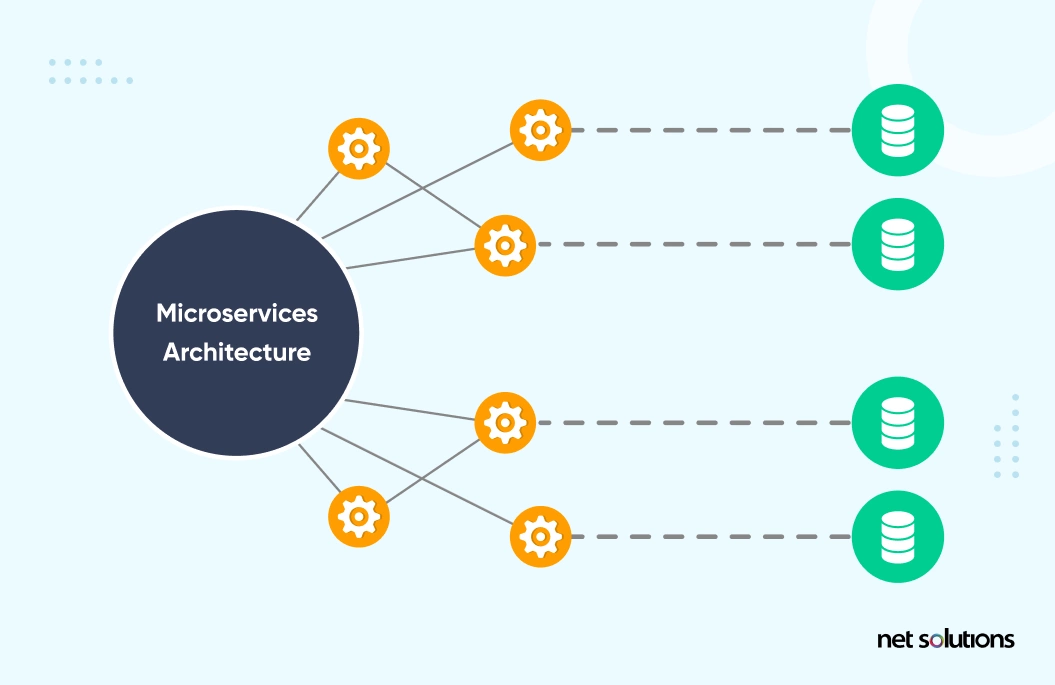
Microservices architecture is based on linking various independent services together in the back end and connecting to a decoupled front end via API. With a microservices architecture, an application is built as separate components that run each process for the application as a service, communicating via the APIs. Each service offers a specialized function or capabilities, so it is easy to pick and choose services to build an overall product that is much more customized. Here are the advantages of microservices:
- Components are only loosely coupled by API, with fewer interdependencies, making it easier to update or replace a module
- Other modules can reuse Microservices
- Module code base makes it easier for developers to learn each module, to find bugs, or to make changes without impacting the whole (or working concurrently)
- Development is accelerated by the ability to reuse code, choose robust technologies and frameworks, and support iterative development.
- Scaling is faster and cheaper since each microservice can scale independently, and it’s easier to spot bottlenecks.
- It’s designed for failure – one module going down will not impact the entire application.
- Each microservice can use the technology stack best for its operations.
A – API-first
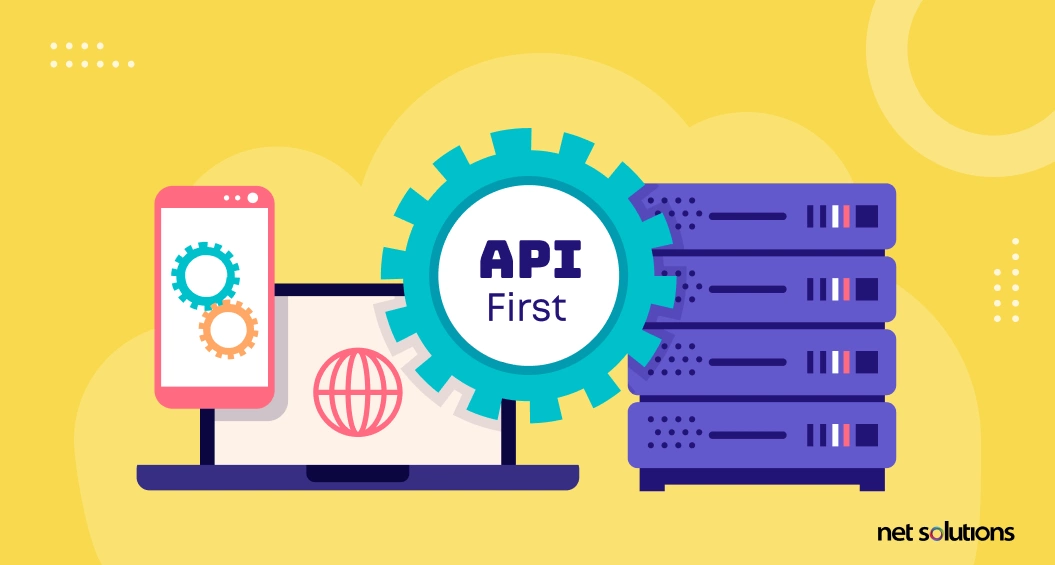
First, an Application Programming Interface (API) is a way that two or more computer programs (services or APIs) communicate – in the case of computers, this means exchanging data and functionality.
In a legacy software environment, software was built then an API would be added on through an extension or an API. In an API-first project, the API is not an afterthought – it is a core concept built into how the product is developed and the role that APIs play in making everything happen. Everything is designed to share and communicate.
Core elements of an API-first design include:
- The API is a core product that has to be designed and maintained
- The API is not an after-thought; it’s a foundational part of the product design
- The API-first approach is more collaborative with the whole product team to ensure all operations around the API are supported.
- The API-first approach is designed for reusability to connect to different systems (ideally suited for microservices)
C – Cloud-native

-Cloud-native architecture designs applications or services made specifically to exist in the cloud: public, private, or hybrid. In cloud-native infrastructure, all servers, databases, and software reside in the cloud. The opposite of cloud-native would be on-premise, an infrastructure hosted in a physical location located to the business.
The benefits of a cloud-native architecture are well-established, from security and resiliency to reduced downtime, improved performance, and the ability to access applications from anywhere. Cloud-native applications can be scaled rapidly on demand and can be containerized to isolate them from the architecture, helping reduce dependencies.
H – Headless
In headless, the front-end and back-end have been decoupled and connected via API. Developers have more choice over the front-end and back-end technologies, allowing for more best-of-breed solutions and the ability to customize the product to multiple front-ends (e.g., iOS, Android, etc.). There are multiple code bases.
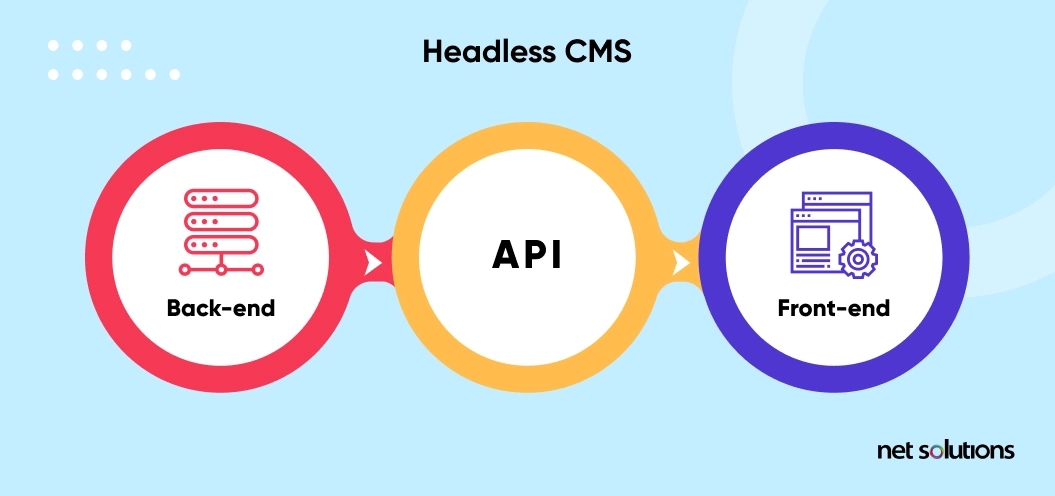
There are many advantages to headless architecture:
- Front-end agnostic – content can be sent via API to different channels or platforms, making it ideal for an omnichannel approach
- Faster editing – can push edits to all channels and platforms, speeding up the updates.
- Developer flexibility – Developers and designers can use any language or framework rather than limit themselves to their legacy CMS’s bounds. System upgrades or new presentation layer changes are rapid and do not impact the creation of new content. Sometimes, this can reduce development time from weeks to a single day.
- Scalable – The service speed is not tied to the database size, and the application can be built to adjust cloud infrastructure to any surges.
- Enhanced security – A single vulnerability in a plugin, theme, or extension can take down an entire traditional program. Still, a headless program minimizes risk by allowing greater choice in microservices and greater separation of services from content.
- Future-proof – A headless program is neutral by nature, allowing for the addition of microservices to adapt to new technology or experience options and offering the limitless capability to connect to new platforms or channels as they emerge.
Want to know about how Headless applies to eCommerce? Read on for The Ultimate Guide to Headless CMS.
What is the Difference Between Monolith and MACH Architecture?
Traditional architecture is often referred to as monolith (or monolithic). In this structure, there is a single application that is made up of three parts:
- The front-end – This is also called the user interface (UI) / presentation layer / client-side, the part of the application that displays the user interactions.
- The business logic – This is the logic that drives what the application can do and its features, sometimes called the server side.
- The data interface is the data access layer that communicates with the database.
In a monolithic architecture, there is a single code base for everything written in one programming language that is then connected to a database:
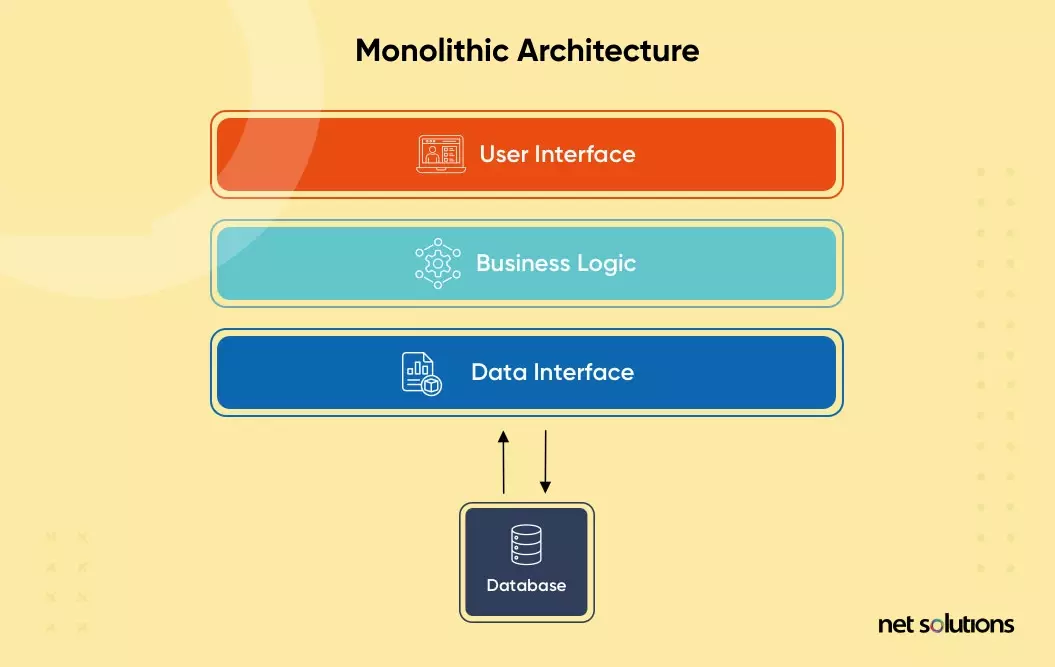
The front and back end in MACH architecture are decoupled, with a loose organization of services (the business logic) to support the application, all connected by API. The decoupling of services helps release any interdependencies among features, allowing for faster development, fewer bugs and dependencies, and greater flexibility to swap out services without impacting the whole:
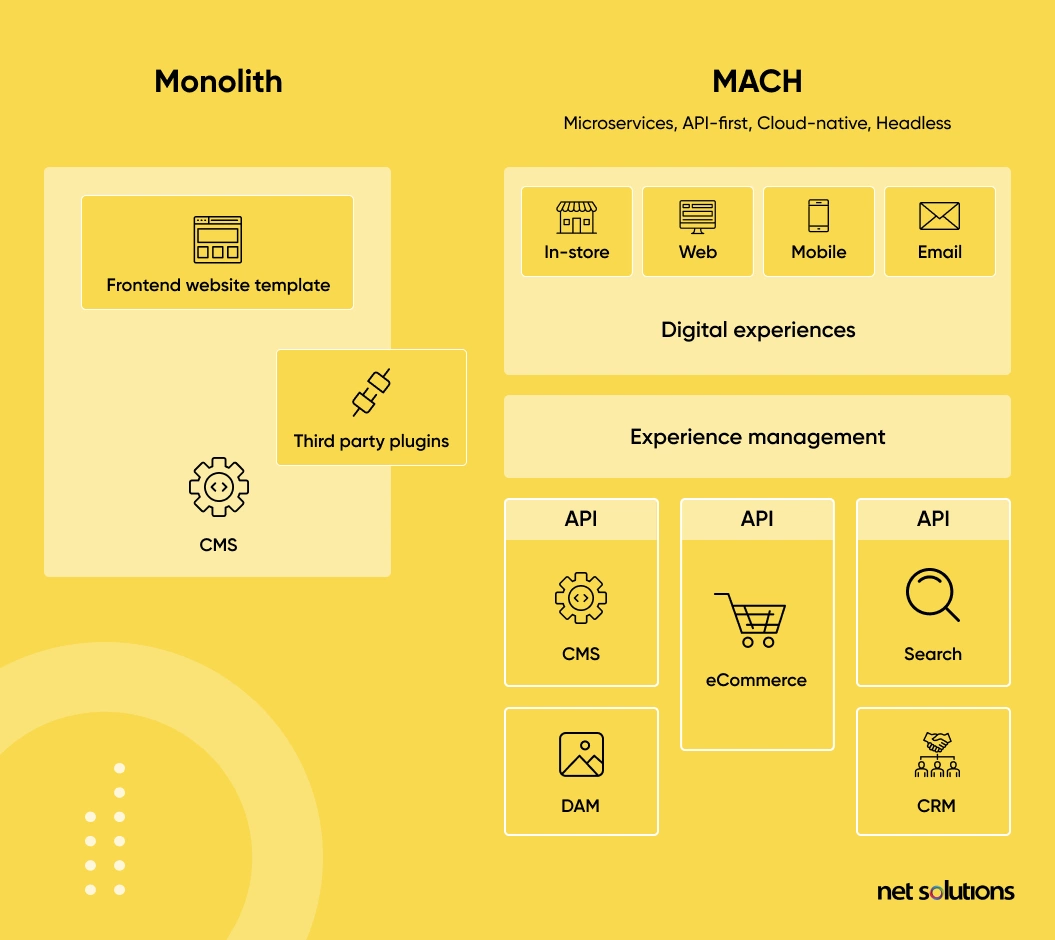
Challenges Presented By Monolith Legacy Systems

While a monolithic system can be easy to design and cost-effective, it has several disadvantages. At the architecture level alone, considering the comparison between Monolithic vs. Microservices, there are several disadvantages:
- Updates to any part of the code base impact the entire code base, requiring a full recompile of the app
- Any errors or server issues affect the whole application, impacting its reliability
- Code reuse is limited, often only supported with shared libraries (leading to coupling issues)
- Changes to any part of the app code become expensive due to dependencies in the code
- The code base can become significant over time, marking it challenging to maintain and for new developers to contribute.
- It does not support horizontal scaling (vertical scaling requires that the whole application be loaded onto multiple servers), so everything scales when only a part of the application may be experiencing a large load.
- Tied to a single technology stack for everything
Microservices architecture solves many problems, developing an application as multiple independent blocks. microservices is just one piece of the puzzle for MACH architecture. It leverages the cloud vs. on-premise servers and stacks and is supported by APIs attached to plugins or extensions. These combine to move MACH architecture from a legacy structure into a more flexible, high-performance, scalable solution for modern needs.
How Does MACH Architecture Work?
MACH Architecture is a structure that allows organizations to choose the best tools for the job, with incredible flexibility over languages for each service and the ability to replace each independent service as the ecosystem evolves to external forces.
Unlike the single code base adopted in Monolithic architecture, MACH architecture is about loosely coupled pieces. In the case of an eCommerce platform, each eCommerce service (shopping cart, product database, support, search, etc.) may be a different service (app or module), each with its capability to scale, load balance, and execute independently of each other. Each service communicates to others via API. To the customer, the experience appears seamless. Because MACH is also headless, the experience is seamless regardless of which front-end system is used, allowing brands to optimize the retail experience and support.
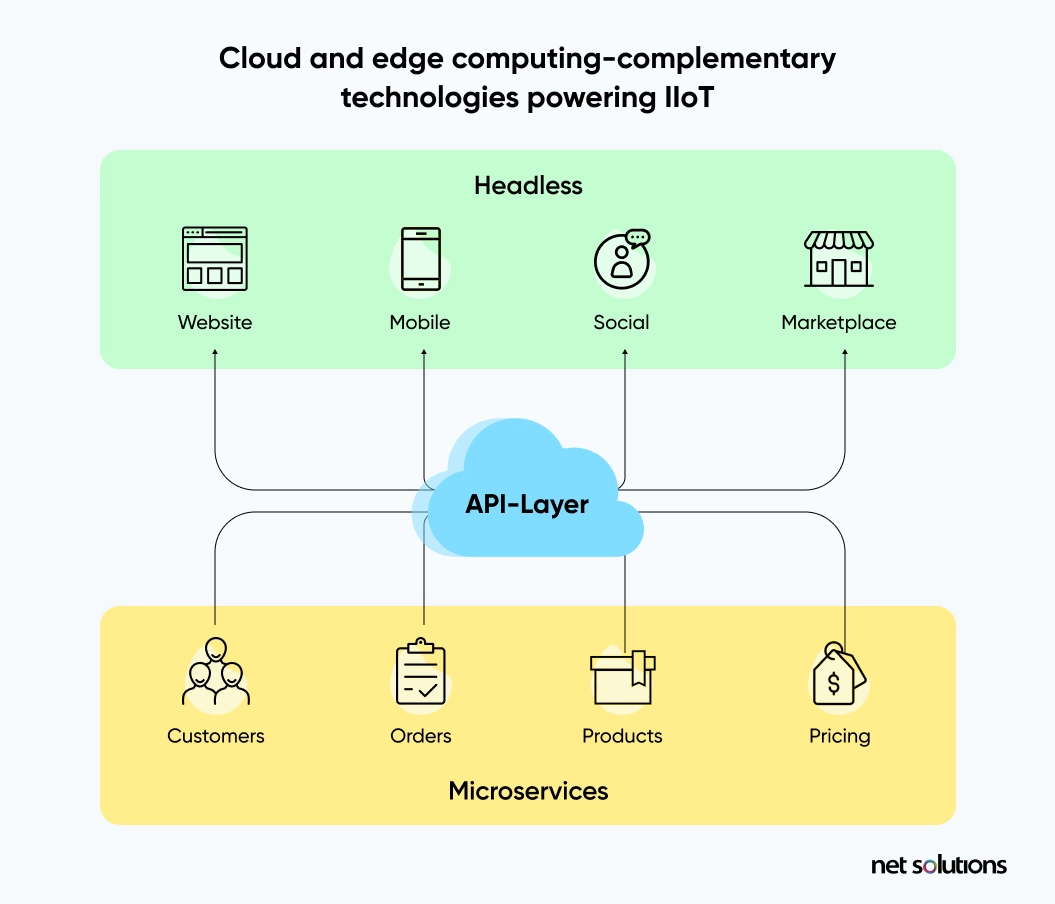
Examples of MACH Architecture
MACH Architecture is common across retail environments, including:
Amazon
Amazon is one of the biggest online retailers and an early adopter of MACH architecture. As noted in their own story, Amazon shares how early iterations of the website were monolithic, which led to slow development and slow release of new features.

“This traditional, single system approach to web development involved complex team coordination and extensive, time-consuming, and tedious regression testing every time the company released a new version of the website or deployed a fix to resolve an issue.”
Amazon implemented MACH architecture in 2006 and has since been a strong proponent of this modern architecture. Amazon Web Services (AWS) has joined the MACH Alliance to further support the advancement of open, modern architecture for digital experiences.
Uber
Uber is another organization that shifted to MACH Architecture to support better its complex eCommerce solution (what customers see) and its complex dispatch library (what drivers see). All the various microservices to manage passengers, track travel, and support payments are connected via API.

Frequently Asked Questions
1. Can MACH architecture be considered the future of digital customer experience?
MACH has been gaining popularity for customer experience systems. It separates the customer experience into microservices and provides more flexibility, capability, and scalability than monolithic architecture. It has been adopted by some leading global companies, is well-suited for fast-growing businesses, and is now considered the future of digital customer experience.
2. Is it essential to use all components of MACH architecture?
Each of the above four building blocks is required to support the overall strategy of MACH.
3. Is headless CMS needed for MACH architecture?
A headless CMS provides only what is needed to manage content, with no front end, meeting all the requirements for MACH. A CMS is integral to the technology stack for eCommerce.
4.Is MACH only applicable to ecommerce projects?
While MACH has been integral to modern digital commerce experiences, helping reduce downtime and providing seamless and evolving expertise across platforms, the same architecture can support any product that relies heavily on experience.



